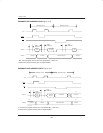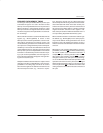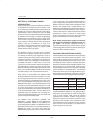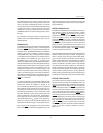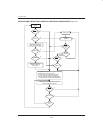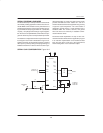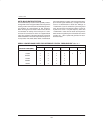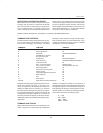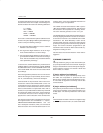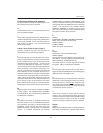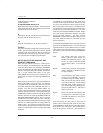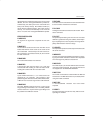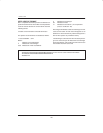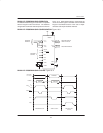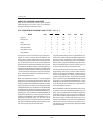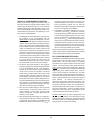
USER’S GUIDE
050396 135/173
136
An address will always be the right–most four digits of a
hexadecimal number. For example, the following hexa-
decimal numbers will result in the following addresses:
A → 000AH
AB → 00ABH
ABC → 0ABCH
ABCD → 0ABCDH
ABCDE → 0BCDEH
The D and F commands allow optional addresses to be
entered. The syntax [Begin–Address [End–Address]] is
used to convey the following meanings:
a) No arguments: Begin–Address is set to 0 and End-
Address is set to the Range.
b) One argument: Begin–Address is set to the argu-
ment and End–Address is set to the Range.
c) Two arguments: Begin–Address is set to the first ar-
gument and End–Address is set to the second argu-
ment. This second address may exceed the address
value specified by the Range.
In cases b and c, the End Address may not be less than
the Begin Address, either implicitly or explicitly. RAM will
be addressed from 0 to 1FFF for 8K RAM and from 0 to
7FFF for 32K RAM. This maximum value is determined
by the Range.
Error messages will be printed as soon as errors are de-
tected. All messages are preceded by the two charac-
ters ‘E:’, and followed by a mnemonic description.
Commands will not be processed until an entire com-
mand line is entered and terminated with a <CR>. No
command line may be greater than 16 bytes, which is
the maximum number of characters in the K command.
Since a command line is not processed until a <CR> is
entered, it may be edited with the delete key which will
do a destructive delete to the screen. Lines longer than
16 characters will cause an error message to be dis-
played and no action to be taken on the command line.
Only legal characters will be echoed back to the screen.
The legal characters are: 0123456789 <:>, <space>,
ABCDEFGHIJKLMNOPQRSTUVWXYZ, and <de-
lete>. Backspace characters (<BS>) are converted to
delete characters. The horizontal tab character is con-
verted to space. Lower case alphabetic characters are
converted to upper case alphabetic.
The <delete> character is executed as a <BS> <space>
<BS> when possible in command mode. This will cause
the character to be overprinted on a hardcopy device.
The <CR> character generates a <CR> <LF> pair.
The Serial Bootstrap Loader will respond to XOFF char-
acters by stopping transmission as soon as the charac-
ter is received. A control–C or an XON will resume serial
transmission. The Serial Bootstrap Loader will not
transmit a XOFF character. The program is able to keep
up with input as long as the receiver can keep up with its
output. The receiver should be programmed to quit
transmission after it sends an XOFF and transmit any-
thing before sending an XON.
Intel Hex data is not echoed unless the Trace mode is
toggled on.
COMMAND SUMMARIES
^C
Interrupt whatever is going on, clear all the buffers, put
up a prompt and wait for the next command. Anything in
the type–ahead buffer is removed. All output is stopped.
If trace had been on before, it is cleared. If XOFF had
been in effect, it is cleared.
C [begin–address [end–address]]
Return the CRC–16 (cyclic redundancy check) of the
NV RAM. This computation is performed over the
Range unless optional start and end addresses are giv-
en. The CRC–16 algorithm is commonly used in data
communications.
D [begin–address [end–address]]
Dump memory in Intel Hex Format. An optional address
range may be specified. Each record will contain up to
32 data bytes. The last line printed is the end–of–data
record.
E
The serial loader is exited. This works if a negative edge
on PROG was used to invoke it, or a CRC check failed.



